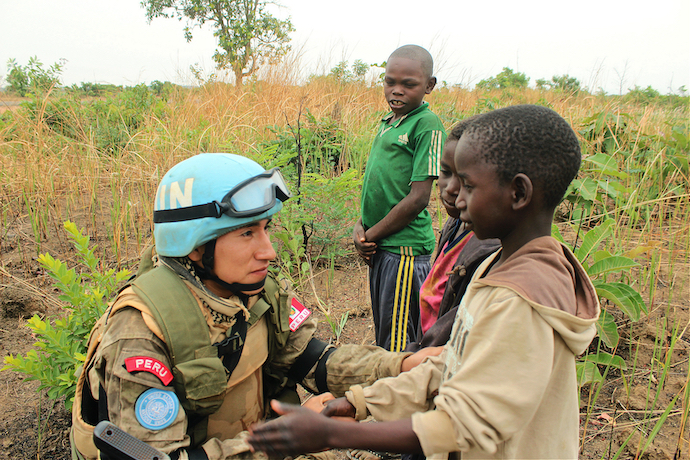
Peru’s Nobel Prize Winning Batallón Peru Turns 50
Batallón Peru, which participated in the United Nations Emergency Force II (UNEF II) in the Middle East in the early 1970s, celebrates its 50th anniversary this year. Peru has a strong history of participation in UN peacekeeping operations, and UNEF II stands out for its significance and inspiration toward future missions.
For its participation in UNEF II, Batallón Peru received the Nobel Peace Prize in 1988.
Making history in the Middle East
In 1973, the Yom Kippur War broke out between Israel and a coalition of Arab states led by Syria and Egypt. The war coincided with the Jewish religious holiday of Yom Kippur; thus, the conflict has been dubbed the Yom Kippur War (or the Ramadan War).
In response to the hostilities, the United Nations General Assembly created UNEF II. At the time, Peru was being governed by General Juan Velasco Alvarado who rose to power following a successful coup d’état, and the country was also a rotating member on the UN Security Council.
Velasco believed that deploying Peruvian UN peacekeepers on this mission was an excellent opportunity to demonstrate the level of preparedness of the Peruvian military after a vast modernization program that his government was carrying out at the time. Peru’s participation in UNEF II concluded in 1975 when Velasco ordered them to return to Lima. In total, the South American country deployed 497 military personnel. The role of Batallón Peru was detailed in a book written by the then-commander, Colonel Christian Sánchez Campos, titled Batallón Especial Perú: Una Misión Singular.
In his book, Campos describes their training before being deployed to the region, the voyage itself, and the operations that Batallón Peru performed both in the Sinai Peninsula along the Israel-Egypt border and in the Golan Heights between Israel and Syria as part of UNEF II and the United Nations Disengagement Observer Force (UNDOF). The operations included demining, providing medical services to wounded soldiers from both sides and repatriating the bodies of dead combatants.

In addition, Batallón Peru served as a line of separation between the armies of Israel, Egypt, and Syria, to avoid renewed hostilities. For example, Batallón Peru was part of the Operation Calendar, which worked to disengage the armies of Egypt and Israel. It is worth mentioning that Ireland, Sweden, Panama, and Peru formed the North Brigade of UNEF II.
While the Peruvian UN personnel on the ground did not engage in direct combat, this does not mean that they didn’t experience any loss of life. On March 15, 1974, they lost three peacekeepers during a routine patrol mission when an antipersonnel mine exploded. The dead included Corporal Rodolfo Neira Córdova, Javier Espinoza Sánchez, and Vicencio Rosas Regalado.
In 1988, in recognition for their participation in UNEF II, Batallón Peru received the Nobel Peace Prize. The only other Peruvian to receive a Nobel is the often-controversial Spanish-Peruvian writer Mario Vargas Llosa who won the Nobel Prize in Literature in 2010.
Peru’s ‘Blue Helmets’ today
Since 1975, Peru has continued to participate in various UN peacekeeping operations, including the controversial UN peacekeeping mission in Haiti and the ongoing UN peacekeeping mission in the Central African Republic (MINUSCA). MINUSCA is Peru’s largest deployment with eight staff officers, 220 peacekeepers, seven experts on mission, and two police officers. In 2020, I interviewed a Peruvian Army captain deployed in the Central African Republic for Geopolitical Monitor. Other Peruvians are assigned to UN peacekeeping missions in the Horn of Africa, the Democratic Republic of the Congo, and Lebanon.
In May, over 250 Peruvians had successfully completed their training at the country’s peacekeeping training facility for their future deployment to the Central African Republic. Eventually, 220 Peruvians departed in late June for the country. The Peruvian contingent is tasked with repairing and maintaining airfields and other transportation infrastructure and removing explosives. Next year about this time, the Peruvian contingent will rotate out of the country.
UN peacekeeping missions have evolved over the decades, adapting to complex situations on the ground. Their operations also depend primarily on the missions’ specific mandates and objectives.
However, as the Council on Foreign Relations explains, there are some common characteristics across all missions: “To protect civilians in armed conflicts, prevent or contain fighting, stabilize post-conflict zones, help implement peace accords, and assist democratic transitions.” Typical tasks include demining, electoral assistance, protection of human rights, and the disarmament/demobilization and reintegration of combatants.
Five decades ago, when Peruvian UN peacekeepers were sent to the Middle East to participate in UNEF II, peacekeeping operations were still a relatively new concept. The first UN peacekeeping mission was to observe and maintain a cease-fire after the 1948 Israeli-Arab War, while Peru’s first participation was relatively early: the UN mission in Lebanon in 1958.
In 2023, Batallón Peru celebrates five decades since their historical deployment and enjoys a well-deserved Nobel Peace Prize. While the Middle East remains a tense and often violent region, Peruvian United Nations peacekeepers risked (and gave) their lives to make that region a better place.
